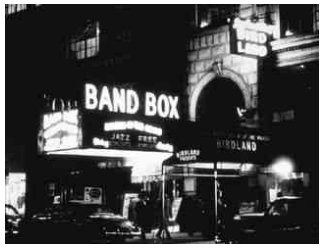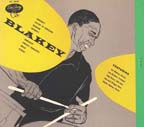Salute To Birdland – Gigi Gryce
In this uptempo swing, Gigi Gryce borrows changes from I'll Remember April and transforms them into an entirely new composition. Lead sheets and second parts available, plus transcriptions of Gryce's alto sax solo and Joe Gordon's trumpet solo. We also have a "Gigi Gryce Project" version available with Minus You audio tracks for all instruments as well as a full quintet track.
- Recording: Art Blakey - Blakey
- Recorded on: May 20, 1954
- Label: EmArcy (MG 26030)
- Concert Key: G
- Vocal Range: , to
- Style: Swing (uptempo)
- Trumpet - Joe Gordon
- Alto Sax - Gigi Gryce
- Piano - Walter Bishop, Jr.
- Bass - Bernie Griggs
- Drums - Art Blakey
- Description
- Historical Notes
- Solos
- Piano Corner
- Bass Corner
- Drum Corner
- Guitar Corner
- Inside & Beyond
- Minus You
Note that the lead sheets for the Blakey version and the Gryce Project version are not identical. The Minus You Gryce Project lead sheets work as stand-alone lead sheets but are also tailored to the Minus You audio tracks.
Two more great Gryce titles from the "Blakey" recording are also available: Hello and Minority.
Learn more about Gigi Gryce at Noal Cohen's Jazz History website. Also see Gryce's discography.
Related Songs
Email Send Salute To Birdland to a friend
- Recording: Gigi Gryce - The Gigi Gryce Project
- Recorded on: August 31, 1999
- Label: jazzleadsheets.com (JLS 1024)
- Concert Key: G
- Vocal Range: , to
- Style: Swing (uptempo)
- Alto Sax - Bobby Porcelli
- Tenor Sax - Ralph Moore
- Piano - Richard Wyands
- Bass - Peter Washington
- Drums - Kenny Washington
Video
- Description
- Historical Notes
- Solos
- Piano Corner
- Bass Corner
- Drum Corner
- Guitar Corner
- Inside & Beyond
- Minus You
Unlike most of our Minus You songs, this arrangement does not have separate piano, bass, and drum parts. Instead, we have a single Rhythm Section part which has all the information necessary for each rhythm section instrument to play along with their respective Minus You track. Though the piano and drums have some hits with the melody, the bass walks throughout except the last measure of the bridge.
Note that the lead sheets for the Blakey version and the Gryce Project version are not identical. The Minus You Gryce Project lead sheets work as stand-alone lead sheets but are also tailored to the Minus You audio tracks.
Don Sickler: Looking at my Historical Notes for the Blakey recording, I now have a little different perspective of at least the Band Box name, since I found this photo on the internet of the Band Box club right next to Birdland:

I was determined to have saxophonist Ralph Moore on "The Gigi Gryce Project" recording, even though he had already left the New York area for the West Coast and his Tonight Show job. I suggested he record this composition partly because I remembered having a great time when I got a chance to record it with Ralph myself in 1986. I (on trumpet) and Ralph had the honor to play on guitarist Jimmy Gourley's session. Jimmy was also on Gigi's original recording (with Clifford Brown), where the composition was called Salute To The Band Box, as it was on Gourley's 1986 session. The session, recorded by Rudy Van Gelder, was memorable in many ways, and it was the first time that either Ralph or I got to record with drummer Victor Lewis.
Minus You audio These are tracks from the quintet recording. The rhythm section editions are simply explained: minus either piano, bass or drums. The minus melody practice edition has additional solo space, because the original track had a piano solo; the piano solo has been eliminated, giving the melody instrument a chance to solo with just bass and drums. Rhythm section players: get the rhythm section part.
The following shows a breakdown of each track edition. There are five Minus You MP3s, with different combinations of instruments.
clip This is the format of the complete recording:
-- melody
-- alto sax break and solo 2 choruses
-- tenor sax solo 2 choruses
-- piano solo 2 choruses
-- saxes trading 8s with drums 1 chorus
-- out melody
[clip] minus melody practice edition (see note below) - 6 solo choruses (the piano has been removed for the piano solo choruses; solo on these choruses accompanied by bass and drums only)
-- count off sets up melody
-- play the melody
-- solo - start with break and play 4 choruses with full rhythm section
-- solo 2 more choruses with just bass and drums
-- trade 8s with drums 1 chorus
-- play the out melody
minus melody performance #1: 4 solo choruses
minus melody performance #2: 2 solo choruses
[clip] minus piano
-- count off sets up melody
-- comp for the melody
-- comp for the alto sax solo 2 choruses
-- comp for the tenor sax solo 2 choruses
-- solo 2 choruses
-- comp for saxes trading 8s with drums 1 chorus
-- comp for the out melody
[clip] minus bass
-- count off sets up melody
-- walk for the melody
-- walk for the alto sax solo 2 choruses
-- walk for the tenor sax solo 2 choruses
-- walk for the piano solo 2 choruses
-- walk for saxes trading 8s with drums 1 chorus
-- walk for the out melody
[clip] minus drums - finger snaps have been added for the third beat of each measure in the trading section
-- count off sets up melody
-- comp for the melody
-- comp for the alto sax solo 2 choruses
-- comp for the tenor sax solo 2 choruses
-- comp for the piano solo
-- trade 8s with saxes (sax first) 1 chorus CLIP
-- comp for the out melody
[clip] bass & drums only practice - to feature piano, guitar, vibes, or any melodic instrument that likes to play without harmonic accompaniment (only bass & drums on the track): 4 solo choruses
trio performance 2 solo choruses These tracks have the same format as the minus melody performance editions.
Note from trumpet player Don Sickler: When I was a young trumpet player growing up in Spokane, Washington, I would have given anything to have minus you tracks to play with. Keeping that in mind, now that I'm able to create those editions, for the melody/soloist I feel it's sometimes helpful to have two different editions. Since our Minus You editions often come from recordings that originally had several different soloists, having a track with all or most of this solo space can be very helpful in giving you lots of room to experiment (our practice edition). But, for example, to use it as an audition tape, the track would need to be shorter. Therefore, we have sometimes created a "performance" edition as well, with fewer solo choruses.
Related Songs
Email Send Salute To Birdland to a friend

Gigi Gryce
November 28, 1925 – March 17, 1983
Gigi Gryce was a fine altoist in the 1950s, but it was his writing skills, both composing and arranging (including composing the standard Minority) that were considered most notable. After growing up in Hartford, CT, and studying at the Boston Conservatory and in Paris, Gryce worked in New York with Max Roach, Tadd Dameron, and Clifford Brown. He toured Europe in 1953 with Lionel Hampton and led several sessions in France on that trip. Read more...




